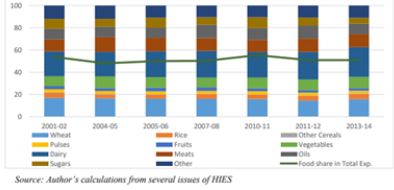Unraveling Nutritional Landscapes: A Holistic Examination of Food Utilization, Sustainability, and Childhood Nutrition in Pakistan
Keywords:
Dietary Problems, Malnutrition, Environmental Issues, Socio-Economic Status, Sedentary BehaviorAbstract
The majority of developing countries have ongoing dietary problems. This comprehensive review delves into the multifaceted landscape of food utilization, sustainability, and nutritional challenges in Pakistan. The research scrutinizes food insecurity trends, dietary patterns, childhood obesity, and malnutrition. Drawing insights from a dataset encompassing 24,809 residences, the analysis focuses on 16,340 homes, evaluating various food categories and household food insecurity. Findings reveal an alarming increase in food insecurity from 58% (2005-2006) to 77.4% (2013-14), with urban households experiencing higher vulnerability. Seasonal variations in food consumption highlight the importance of tailored interventions. Examining sustainability, the study addresses environmental issues, water resource depletion, population growth, and governance disparities affecting future food supply stability. Sustainable Food and Nutrition Security is explored through socially, economically, and environmentally sustainable measures, emphasizing the necessity of shaping public policies for enduring food security. The study underscores the global concern of childhood obesity and persistent stunting in Pakistan, affecting 38% of children under five. Risk factors include socio-economic status, sedentary behavior, and inadequate physical activity. Recommendations emphasize targeted interventions, parental awareness, and informed initiatives to combat childhood nutrition challenges. Analyzing nutritional consumption patterns, the study unveils deficiencies in protein, vitamins A, B, C, and essential minerals. The income elasticity of consumption is explored through Engel curves, revealing shifts in dietary preferences with economic growth. Noteworthy variations in nutrient consumption across provinces and household sizes underscore the need for tailored policy approaches. In conclusion, the study advocates for poverty alleviation initiatives, such as direct cash transfers, as effective strategies for improving nutritional well-being. The findings emphasize the dynamic interplay between socio-economic factors and dietary choices, urging policymakers to consider holistic approaches for sustainable food security in diverse regions of Pakistan.
References
FAO, IFAD, and WFP, “The State of Food Insecurity in the World. The multiple dimensions of food security. EXECUTIVE SUMMARY,” pp. 1–57, 2014, [Online]. Available: ISBN 978-92-5-108542-4 (print)
A. Bogale, “Vulnerability of smallholder rural households to food insecurity in Eastern Ethiopia,” Food Secur., vol. 4, no. 4, pp. 581–591, Dec. 2012, doi: 10.1007/S12571-012-0208-X.
M. Amare, K. A. Abay, L. Tiberti, and J. Chamberlin, “COVID-19 and food security: Panel data evidence from Nigeria,” Food Policy, vol. 101, May 2021, doi: 10.1016/J.FOODPOL.2021.102099.
S. Feeny and L. McDonald, “Vulnerability to Multidimensional Poverty: Findings from Households in Melanesia,” J. Dev. Stud., vol. 52, no. 3, pp. 447–464, Mar. 2016, doi: 10.1080/00220388.2015.1075974.
“View of Appraisal of Devastation by Droughts in Pakistan.” Accessed: Feb. 22, 2024. [Online]. Available: https://journal.50sea.com/index.php/IJASD/article/view/302/514
UNICEF, “National Nutrition Survey 2018: Key Finding Report,” Gov. Pakistan UNICEF, pp. 1–48, 2018, [Online]. Available: https://www.straitstimes.com/sites/default/files/attachments/2018/11/20/st_20181120_vnd_4427153.pdf
ILO, Social protection for older women and men. Fighting poverty through pension systems. 2017. [Online]. Available: www.ifrro.org
Y. Khan, U. Daraz, and Š. Bojnec, “Enhancing Food Security and Nutrition through Social Safety Nets: A Pathway to Sustainable Development,” Sustain. 2023, Vol. 15, Page 14347, vol. 15, no. 19, p. 14347, Sep. 2023, doi: 10.3390/SU151914347.
M. Asim and Y. Nawaz, “Child malnutrition in pakistan: Evidence from literature,” Children, vol. 5, no. 5, 2018, doi: 10.3390/children5050060.
E. Mukiibi, “COVID-19 and the state of food security in Africa,” Agric. Human Values, vol. 37, no. 3, pp. 627–628, Sep. 2020, doi: 10.1007/S10460-020-10079-9.
B. Dhehibi, J. M. Gil, and A. M. Angulo, “Nutrient effects on consumer demand: A panel data approach,” no. August, pp. 813–823, 2003.
M. Boiret, D. N. Rutledge, N. Gorretta, Y.-M. Ginot, and J.-M. Roger, “Book_Food_Composition_Table_for_Pakistan_.pdf,” Journal of Pharmaceutical and Biomedical Analysis, vol. 90. pp. 78–84, 2014. [Online]. Available: http://linkinghub.elsevier.com/retrieve/pii/S0731708513005530
L. Turner, N. O’reilly, K. Ralston, and J. F. Guthrie, “Identifying gaps in the food security safety net: the characteristics and availability of summer nutrition programmes in California, USA,” Public Health Nutr., vol. 22, no. 10, pp. 1824–1838, Jul. 2019, doi: 10.1017/S1368980018004135.
M. Niño-Zarazúa, A. Barrientos, S. Hickey, and D. Hulme, “Social Protection in Sub-Saharan Africa: Getting the Politics Right,” World Dev., vol. 40, no. 1, pp. 163–176, Jan. 2012, doi: 10.1016/J.WORLDDEV.2011.04.004.
K. Hudecová and M. Rajčániová, “The impact of geopolitical risk on agricultural commodity prices,” Agric. Econ. (Czech Republic), vol. 69, no. 4, pp. 129–139, 2023, doi: 10.17221/374/2022-AGRICECON.
J. Blythe et al., “Social dynamics shaping the diffusion of sustainable aquaculture innovations in the Solomon Islands,” Sustain., vol. 9, no. 1, 2017, doi: 10.3390/SU9010126.
A. Tung, R. Rose-Redwood, and D. Cloutier, “Breadlines, victory gardens, or human rights?: Examining food insecurity discourses in Canada,” Can. Food Stud. / La Rev. Can. des études sur l’alimentation, vol. 9, no. 2, pp. 249–275, Jul. 2022, doi: 10.15353/CFS-RCEA.V9I2.530.
J. A. Foley et al., “Solutions for a cultivated planet,” Nat. 2011 4787369, vol. 478, no. 7369, pp. 337–342, Oct. 2011, doi: 10.1038/nature10452.
Y. Subramaniam, “Population Growth, Biofuel Production and Food Security,” Green Low-Carbon Econ., Aug. 2023, doi: 10.47852/BONVIEWGLCE3202948.
“Sustainability | Free Full-Text | Enhancing Food Security and Nutrition through Social Safety Nets: A Pathway to Sustainable Development.” Accessed: Feb. 16, 2024. [Online]. Available: https://www.mdpi.com/2071-1050/15/19/14347
R. Ingutia and J. Sumelius, “Determinants of food security status with reference to women farmers in rural Kenya,” Sci. African, vol. 15, Mar. 2022, doi: 10.1016/J.SCIAF.2022.E01114.
L. C. Smith and T. R. Frankenberger, “Does Resilience Capacity Reduce the Negative Impact of Shocks on Household Food Security? Evidence from the 2014 Floods in Northern Bangladesh,” World Dev., vol. 102, pp. 358–376, Feb. 2018, doi: 10.1016/J.WORLDDEV.2017.07.003.
J. Bhattacharya, J. Currie, and S. Haider, “Poverty, food insecurity, and nutritional outcomes in children and adults,” J. Health Econ., vol. 23, no. 4, pp. 839–862, 2004, doi: 10.1016/j.jhealeco.2003.12.008.
S. J. Malik, H. Nazli, and E. Whitney, “Food consumption patterns and implications for poverty reduction in Pakistan,” Pak. Dev. Rev., vol. 54, no. 4, pp. 651–669, 2015, doi: 10.30541/v54i4i-iipp.651-670.
K. Mudassar, B. Aziz, and A. Anwar, “Estimating consumer demand of major food items in Pakistan: A micro data analysis,” Pakistan J. Life Soc. Sci., vol. 10, no. 1, pp. 53–58, 2012.
A. Economics and D. Library, “globe due to the work of AgEcon Search . Conceptual framework for the analysis of the determinants of food and nutrition security”.
J. Su et al., “Expression of barley SUSIBA2 transcription factor yields high-starch low-methane rice,” Nat. 2015 5237562, vol. 523, no. 7562, pp. 602–606, Jul. 2015, doi: 10.1038/nature14673.
F. Zhang et al., Integrated Nutrient Management for Food Security and Environmental Quality in China, 1st ed., vol. 116. Elsevier Inc., 2012. doi: 10.1016/B978-0-12-394277-7.00001-4.
R. Anker, “Engel’s Law around the World 150 Years Later,” Polit. Econ. Res. Inst., no. 247, pp. 1–46, 2011, [Online]. Available: http://www.peri.umass.edu/fileadmin/pdf/working_papers/working_papers_201-250/WP247.pdf
U. Afzal, “The Determinants of Child Health and Nutritional Status in Punjab: An Economic Analysis,” Creb, no. 02, 2012, [Online]. Available: http://www.creb.org.pk/uploads/file/5fc29f0a5585da206c994d09b7c61c6eWorking Paper No. 02-12 Final Complete.pdf
J. Strauss and D. Thomas, “Chapter 34 Human resources: Empirical modeling of household and family decisions,” Handb. Dev. Econ., vol. 3, no. PART A, pp. 1883–2023, 1995, doi: 10.1016/S1573-4471(05)80006-3.
S. L. James et al., “Global, regional, and national incidence, prevalence, and years lived with disability for 354 Diseases and Injuries for 195 countries and territories, 1990-2017: A systematic analysis for the Global Burden of Disease Study 2017,” Lancet, vol. 392, no. 10159, pp. 1789–1858, Nov. 2018, doi: 10.1016/S0140-6736(18)32279-7.
S. Yang, N. Bhargava, A. O’Connor, E. R. Gibney, and E. L. Feeney, “Dairy consumption in adults in China: a systematic review,” BMC Nutr., vol. 9, no. 1, pp. 1–27, 2023, doi: 10.1186/s40795-023-00781-2.
K. Kh’ng, C. C. Chang, and S. H. Hsu, “Implications of food and nutrition security on household food expenditure: the case of Malaysia,” Agric. Food Secur., vol. 11, no. 1, pp. 1–13, 2022, doi: 10.1186/s40066-022-00367-4.
S. A. French, C. C. Tangney, M. M. Crane, Y. Wang, and B. M. Appelhans, “Nutrition quality of food purchases varies by household income: The SHoPPER study,” BMC Public Health, vol. 19, no. 1, pp. 1–7, 2019, doi: 10.1186/s12889-019-6546-2.
M. C. A. Wegerif, “‘Informal’ food traders and food security: experiences from the Covid-19 response in South Africa,” Food Secur., vol. 12, no. 4, pp. 797–800, Aug. 2020, doi: 10.1007/S12571-020-01078-Z.
C. Brewster, I. Roussaki, N. Kalatzis, K. Doolin, and K. Ellis, “IoT in Agriculture: Designing a Europe-Wide Large-Scale Pilot,” IEEE Commun. Mag., vol. 55, no. 9, pp. 26–33, 2017, doi: 10.1109/MCOM.2017.1600528.
A. Haider and M. Zaidi, “Munich Personal RePEc Archive Food Consumption Patterns and Nutrition Disparity in Pakistan Food Consumption Patterns and Nutrition Disparity in Pakistan,” 2017.
J. L. Leroy, M. Ruel, E. A. Frongillo, J. Harris, and T. J. Ballard, “Measuring the Food Access Dimension of Food Security: A Critical Review and Mapping of Indicators,” Food Nutr. Bull., vol. 36, no. 2, pp. 167–195, Jun. 2015, doi: 10.1177/0379572115587274.
Institute of Medicine, “Dietary reference intakes (DRIs): Recommended dietary allowances and adequate intakes,” vol. 6, pp. 4–5, 1998, [Online]. Available: www.nap.edu.
I. P. Novotny, P. Tittonell, M. H. Fuentes-Ponce, S. López-Ridaura, and W. A. H. Rossing, “The importance of the traditional milpa in food security and nutritional self-sufficiency in the highlands of Oaxaca, Mexico,” PLoS One, vol. 16, no. 2 February 2021, pp. 1–21, 2021, doi: 10.1371/journal.pone.0246281.
J. Zhao, J. Huang, and F. Nie, “The Income Elasticities of Food, Calories, and Nutrients in China: A Meta-Analysis,” Nutrients, vol. 14, no. 22, 2022, doi: 10.3390/nu14224711.
T. H. E. S. Of, The State of Food and Agriculture 2020. 2020. doi: 10.4060/cb1447en.




